Physical Tour
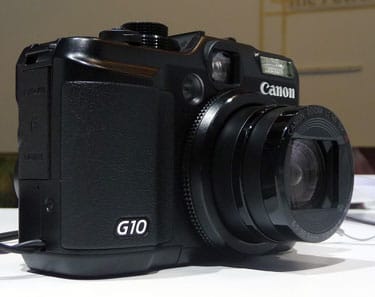
Front
The front of the Canon PowerShot G10 is dominated by it's 6.1 - 30.5mm, 1:2.8-4.5 lens (28mm - 140mm equivalent). Above the lens is the front of the viewfinder. To the right of the viewfinder at two o'clock from the lens is the flash, which is not protected in any way. At ten o'clock from the lens, to the left and slightlly below the viewfinder, is the auto focus assist lamp. The left side of the front has a slightly textured leathery finish, which allows for a better grip with your right hand when holding the camera.
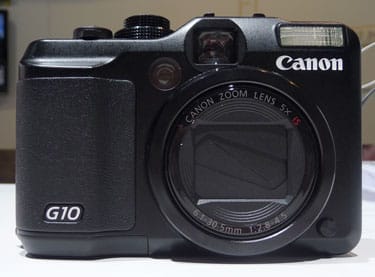
The textured area on the left helps you hold the G10 more securely.
Back
The most prominent feature on the back of the Canon PowerShot G10 is the three-inch 461,000 pixel LCD display, a high-resolution screen compared to most pedestrian point and shoots. Above the LCD you will find the viewfinder with diopter adjustment to the left. Above the top left corner of the LCD is a customizable shortcut button that doubles as a direct print button when playing back photos. Above the top left of the LCD is the playback mode button.
To the right of the LCD are the main set of controls. At the center you will find a standard 4-way pad with a center select button that allows you to access manual focus (up) right (flash) various functions like manual focus with each of the four directions. Surrounding the 4-Way is a rotating dial that can be used to make various adjustments. Above these controls are two buttons for resizing the frame and metering. Below are Menu and Display buttons. At the top right of the back is an AE Lock/Microphone button.down (burst mode / self-timer) and macro (left).*
*
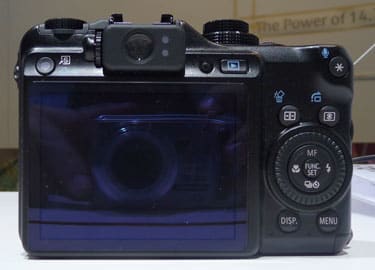
The plethora of controls on the back let you make a lot of one-touch adjustments.
Sides*
*The left side of the Canon PowerShot G10 holds the strap mount and the speaker when playing back video.
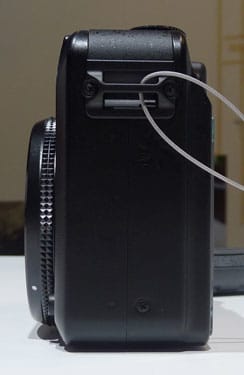
Nothing but a lanyard loop on the left side.**
The right side has a cover that opens up to reveal the A/V Out, Remote Terminal and mini USB port.

*On the right of the G10 you'll find the cover for all the camera's ports.
*
On the top of the Canon PowerShot G10 you'll find another plethora of buttons and controls. Starting on the left you have an Exposure Compensation Dial, Hot Shoe and the microphone for video capture. Next up is a dual-ring dial with ISO controls on the bottom ring and mode controls sitting on top of it. To the right of this is the shutter button that sits atop the zoom toggle, and just behind that is the power button.

The new exposure compensation dial is a welcome addition for manual mavens.**
The bottom of the G10 holds the tripod mount in the center and the cover for the battery and memory card slots to the right of it. This cover slides off to the right, but felt a bit insecure and prone to accidental movement.

The battery cover felt a bit fragile.**
Components
Viewfinder
Purists will appreciate the presence of the Canon PowerShot G10's viewfinder, but don't expect much from it. It's a simple optical viewfinder that won't show you any adjustments or overlay any information.

The viewfinder is a great feature for traditionalists.
LCD Screen
The three-inch LCD display on the back of the G10 is on the largish side for a compact camera. What's really nice, however, is the resolution of 461,000 pixels. Items on the display look sharp and clear whether you're taking a photo or looking at those you've already captured. The display allows you to toggle between limited information on the LCD, a lot of information (including a handy live histogram), and turning the LCD off when you just want to use the viewfinder.
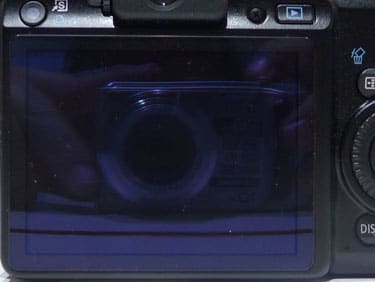
The three-inch LCD has seen a significant upgrade in resolution to 461,000 pixels.
**
Flash
The flash on the Canon PowerShot G10 is located above and to the right of the lens when looking at the camera from the front. One nice feature is Flash Exposure Compensation, which can be accessed in the Function Settings menu and allows you to adjust between +/- 2. If the built-in flash on the G10 isn't enough for you the hot shoe will let you add your own.
**
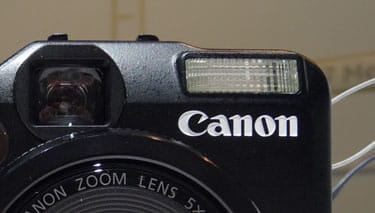
The flash sits just above and to the right of the lens.
******Lens**
The Canon PowerShot G10's lens has a focal length of 6.1-30.5mm and an aperture of 1:2.8-4.5. The focal length is slightly wider than its predecessor the G9, which should enable you to take wider angle shot, and the aperture is a slight improvement from a maximum of 4.8 at the tele end. Both of these improvements are appreciated.

The lens retracts into the body so you can carry the G10 comfortably
in most pockets and bags.
The Canon PowerShot G10 can take a lens adapter for zoom lenses, but will not support a telephoto lens. To add the lens adapter you will first need to remove the small ring found at the base of the lens, which comes free when you press a small button to the lower right of the lens and twist.
Connections
All the connections on the Canon PowerShot G10 are found on the right side beneath a small cover. Here you will find the A/V Out, Remote Terminal and mini USB port.
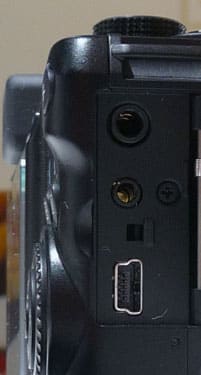
From the top: A/V Out, Remote Control and mini USB ports.
Battery
The G10 uses a proprietary lithium-ion battery that is capable of giving you 400 shots with the LCD on or 1,000 shots without. Playback time is 600 minutes.

The battery and memory card sit right next to each other.**Memory**
The Canon PowerShot G10 supports both standard SD and high-capacity SDHC cards, which currently have a maximum size of 32GB.
Other
The Canon PowerShot G10 is one of a new generation of Canon compacts using the new Digic 4 processor. This offers a significant boost in burst rate, noise suppression and face detection performance.
Design / Layout
Model Design / Appearance
The Canon PowerShot G10 is not a particularly attractive camera, with a blocky appearance and angular lines. It does seem durable, sporting a metal body and chassis that should hold up well to heavy use.
Size and Handling
The G10 is larger and heavier than your typical point-and-shoot camera at 4.3 x 3.06 x 1.81 (109 x 78 x 46mm) inches and weighing in at 12.3 ounces (340g). We believe the professional and semi-pro set the camera is targeted at will appreciate the solid feel and heft of the device, however. It should fit easily into most bags and purses and even most jacket pockets. Don't expect to be able to slip it easily into your jean pocket, especially if they're tight jeans. A cargo pants pocket should be sufficient, though.
When holding the camera in your right hand you'll notice the slightly textured front of the camera that gives you a better grip. There's also a small dip right before you get to the lens that makes it more comfortable to hold. The left side of the camera is not as comfortable: with the LCD display going right up to the left edge you'll have to hold your left hand a bit awkwardly to avoid smudging the screen or obscuring your view of the scene.
The main controls are well placed and sit right next to your right thumb when holding the camera. The Exposure Compensation dial on the left can be easily reached with the thumb of your left hand, but it is stiff and a bit difficult to move. We found the placement of the shutter button to be a bit too far from the right side, especially for those with smaller hands. The mode and ISO dials will likely require that you use both a thumb and forefinger to adjust, requiring you to shift your hand, a negative.*
*
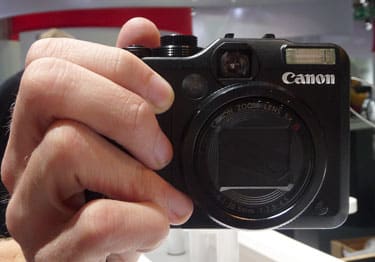
*

- The G10 isn't as small as some compacts, but significantly smaller than an SLR.
Menu
The Canon PowerShot G10 offer two main menu interfaces. The first is accessed with the center select button of the 4-way, which brings up a menu that allows you to adjust White Balance, My Colors, Bracketing, Flash Output, ND Filter, Quality and Size. The ND Filter is an interesting control that reduces light intensity three stops to allow for slower shutter speed and smaller aperture values. The main menu is accessible via the Menu button and gives you a tabbed interface with the typical selection of options. There's also a favorites menu for quick access to those options you use the most.

The main menu is tabbed and include a favorites section.
**
Ease of Use
Those who want a lot of control with features that are not often found on a typical point and shoot will appreciate this camera. Canon has done a good job of making many of these features quickly accessible via various dials and buttons, assuming you know the purpose of these advanced features in the first place. The less advanced photographer who's eager to learn will also welcome this wealth of options. If all you really want is a simple point-and-shoot, though, the G10 may be more intimidating, and more expensive, than necessary.
Modes
Auto Mode**
Auto mode puts most of the advanced options available with the Canon PowerShot G10 beyond your control. Manual Focus, aperture and shutter settings along with metering options are no longer available. Many of the options found under the Function Set menu are not available, with Quality and Size the only ones still functional. Setting white balance manually is not available in Auto Mode either. You can still make adjustments to Exposure Compensation and ISO using the dedicated dials.
Movie Mode
The Canon PowerShot G10 is capable of recording 640 x 480 video at 30fps, which is a pretty typical quality for a point and shoot. We're starting to see cheaper point and shoots with support for 720p video, so VGA is just slightly disappointing on a high-end device like the G10. When recording video you can use some advanced features like manual focus, exposure compensation and ISO control, however only automatic exposure settings are available. In the Function Set menu you'll find controls for White Balance, My Colors, ND Filter and Size. If you want to save some memory you can drop down to a 320 x 240 pixel at 30fps.
**
Drive / Burst Mode**
Burst mode settings are found by pressing Down on the 4-way control. Here you can choose from Continuous and Continuous Auto Focus mode.
Playback Mode
You enter playback mode by hitting the Playback button found just above the top left of the LCD display. When in playback mode you can move between photos using left/right on the 4-way. You can also rotate the dial to quickly scroll through a thumbnail view of your photos, with three visible at any one time. You can trash images by hitting the dedicated delete button just above and to the left of the 4-way, while the button above and to the right will allow you to jump to a specific date, category, folder, or advance by ten or one hundred images at a time.
Custom Image Presets**
Unlike lower-end point and shoot cameras the G10 does not put every scene mode on the mode dial. Instead there is one dial setting for all scene modes. Once there you can move between scene modes by using the rotating dial around the 4-way controller. The available scene modes are ISO 3200, Color Accent, Color Swap, Portrait, Landscape, Night Scene, Sports, Night Snapshot, Kids & Pets, Indoor, Sunset, Snow, Beach, Fireworks, Aquarium and Underwater.*
*
Control Options
Manual Control Options
The Canon PowerShot G10 offers users an excellent selection of manual control options including Program, Shutter Priority, Aperture Priority and Manual modes. This is far more than the typical point and shoot, and approaches the level of control available from SLR cameras.
As if that wasn't enough there's also manual focus, manual white balance and a dedicated dial for exposure compensation, a big plus in a world full of multi-use buttons. Manual focus can be turned on by pressing up on the 4-way controller, and then adjusted using the rotating dial surrounding the 4-way. The G10 provides useful manual focus assist, zooming in on the center of the scene so you can better judge focus accuracy. White balance offers two slots to save white balance settings, a handy feature. All in all the G10 is one of the more impressive compact cameras on the market from a manual control perspective.
Focus
We found the auto focus on the G10 to be quick and responsive, even when we quickly changed scenes or zoomed in. The presence of a manual focus is a major plus, and we found the easy access by pressing Up on the 4-way along with the rotating dial to make actual adjustments to be an intuitive interface on a camera that lacks a focus ring on the lens barrel.

Manual focus on a compact is a welcome feature.
ISO
In another nod to control freaks who love to have a dial for everything, the Canon PowerShot G10 has a dedicated dial for ISO settings. Ranging from 80-1600 in addition to Automatic and a high ISO setting that roughly corresponds to ISO 3200, this allows you to make quick ISO adjustments on the fly without bothering with menus. Of course those who have no idea what ISO is will likely find themselves wondering why there's a dedicated dial for it.
White Balance
White balance settings don't have their own dedicated dial (there's only so much room on the camera, after all), but white balance is the first option available in the Function Set menu, which can be accessed by pressing the center select button of the 4-way. The available white balance options are Auto, Daylight, Cloudy, Tungsten, Fluorescent, Fluorescent H, Flash and Underwater. There are also slots for two manual white balance settings (setting the white balance by shooting a white or grey surface), which provides nice flexibility when moving between different lighting environments.

White balance options include two slots for settings.
**
Metering
The Canon PowerShot G10 has a typical selection of metering options, including evaluative, center weighted and spot metering.

Evaluative, center weighted and spot metering are available.
**
Shutter Speed
The G10 offers a decent range of shutter speeds from 15 to 1/4000. This is an upgrade over the G9's maximum speed of 1/2500.
Aperture
The Canon PowerShot G10 offers a maximum aperture of f/2.5 at the widest setting and f/4.5 at the highest telephoto magnification, a fairly typical range for a point and shoot camera.
**Image Stabilization
**The Canon PowerShot G10 has optical image stabilization for those who have had too much coffee before shooting.
Picture Quality / Size Options
The G10 offers three quality options, Superfine, Fine and Normal. There are seven size options ranging from full size 4416 x 3312 to the smallest at 640 x 480. There's also a Widescreen option that takes photos at 4416 x 2480. More impressive is support for RAW photos at full size, a big plus for high-end shooters. At 14.7 megapixels it's taken a step up from the G9's 12.4 megapixel sensor.*
*
Picture Effects Mode
Once you've taken your photos you can go hog wild with picture effects, including Vivid, Vivid Blue, Vivid Green, Vivid Red, Neutral, Sepia, Black & White, Positive Film, Lighter Skin Tone, Darker Skin Tone and Custom. Go ahead, have some fun.
Conclusion
**
Conclusion**

The successor to the popular G9, the Canon PowerShot G10 represents a meaningful upgrade. Adding quite a few megapixels in resolution, the G10 retains the plethora of manual controls offered by the G9, and adds a new dial for Exposure Compensation. This will make the advanced shooters in the G10 target audience very happy indeed, as will the increased resolution and expanded focal range. The new Digic 4 processor also offers significant upgrades in burst speed, noise suppression and face detection.
Those who are looking for a compact camera that provides image control near those of an SLR will find a lot to like in the G10. That said, the upgrades probably aren't enough for you to trade up if you already own the G9, or a competitor in the same category like the Panasonic Lumix DMC-LX3.
Novice shooters who aren't scared away by the $499.99 price may still be scared away by the plethora of buttons and manual controls. If you're someone who's ready to move into the world of manual control and doesn't want to carry a bulky SLR, though, this might be a good choice for you.
Specs / Ratings
**Specs Table
**{{manufacturer_specs_table}}{{raw_scores_table}}
Meet the tester

Alfredo Padilla
Editor
Alfredo Padilla is a valued contributor to the Reviewed.com family of sites.
Checking our work.
Our team is here for one purpose: to help you buy the best stuff and love what you own. Our writers, editors, and lab technicians obsess over the products we cover to make sure you're confident and satisfied. Have a different opinion about something we recommend? Email us and we'll compare notes.
Shoot us an email